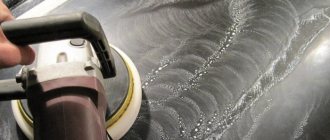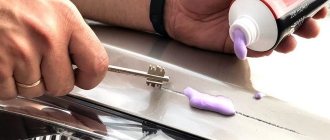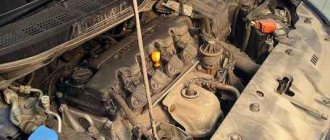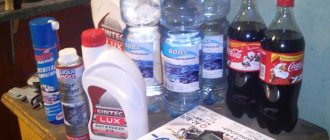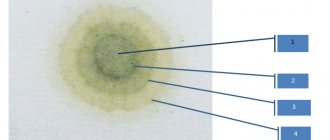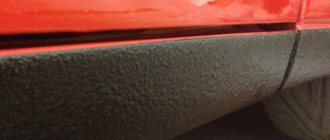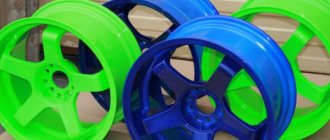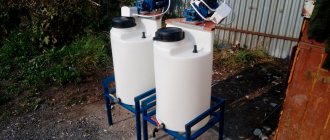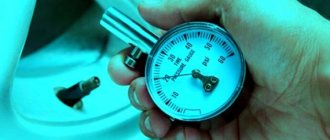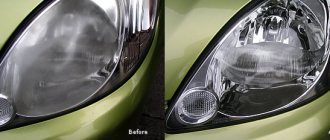Many motorists are naturally interested in the question of how to remove saffron milk caps from the car body. And under such a cheerful name as saffron milk caps or bugs hides an extremely serious problem in the form of rust. In fact, these are small pockets of corrosion that appear on the surface of the body.
Each car comes from the factory with a certain amount of anti-corrosion protection. For some it is better, for others it is worse. It is the task of the car owner himself to protect the car from corrosive processes. If saffron milk caps are left unattended, they will grow and actively spread further.
Therefore, true car enthusiasts are concerned with the question of how to get rid of them, whether this can be done with their own hands and at home. Actually it is possible. The main thing here is to take a responsible approach to completing the task.
How to remove rust from a car body with your own hands
There are several ways to get rid of rust on a car body, but in this material we will look at only the two simplest methods that almost every car enthusiast can handle with his own hands.
- Removing rust mechanically;
- Removing rust using an electrochemical method.
The first method is very cheap, but at the same time more labor-intensive, and the second is quite simple, but the cost of the materials used can sometimes be slightly higher than in the first case.
After removing the rust, it will be advisable to paint over the damaged area on the car body, regardless of which of the methods listed above you choose.
For these purposes, in many cases, cosmetic enamel in the form of a small bubble with a brush, reminiscent of nail polish, is excellent. You can select such enamel to match the color of the body using a fan catalog available in any car shop with a car paint department.
The procedure for removing rust by mechanical and electrochemical methods, as well as their advantages and disadvantages, we will consider below.
We recommend: How to change the brake drum on a VAZ 2107
Mechanical method (step by step instructions)
If you follow the instructions and take your time, you can forget about rust on your car for 1-2 years (at least in the treated areas). The work is carried out in stages:
DIY Tools and Supplies
To work you will need:
The work can be done manually or using special machines
The main thing is to work carefully and slowly. There should be no deep scratches or rough transitions. Try to get a polished surface with smooth gradients.
A grinder is often included in a car enthusiast’s arsenal.
The damaged paintwork is removed layer by layer and subsequent damaged areas are processed.
The longevity of the result depends on the thoroughness of the work.
Universal types of putty, oddly enough, are not suitable for all types of car bodies
It is applied in several layers and each one is sanded until smooth. Your goal is to fill all the depressions and achieve a perfectly smooth surface when the work is completed.
To work, you will need several types of sandpaper.
Do not skimp on protective equipment, especially if you are doing the job for the first time.
Film, newspapers and masking tape are perfect for this. If you work outside, be sure to consider the direction of the wind.
Make sure that dust and other abrasive particles do not fall on the treated surface.
Painting work requires minimal skills!
The result is not always the same as in the photo; it is often necessary to modify and eliminate flaws
A good way to remove and repair rust on a car door (video)
Features of the mechanical method
There is a fairly solid list of videos available on the Internet in which skilled craftsmen and novice car enthusiasts tell and show how you can deal with saffron milk caps yourself in a white, black, silver, etc. car. Moreover, they claim that this can be done quickly and extremely effectively.
Here it is important not to confuse the effective method and advice of a skilled master with a banal advertisement for another supposedly miraculous remedy. No one denies the fact that excellent rust converters exist, but sometimes outright bullshit is advertised, which is of no use at all. You should not rely on the magical properties of expensive auto chemicals with an unclear composition and promises to give the perfect result. It is better to give preference to the old proven method of the mechanical type. He is the one who shows himself at his best.
The method of removing saffron milk caps using the most common AA battery is also gaining popularity. I also heard about this method, but I don’t really trust it. You can experiment, but be careful.
If you have real experience of a non-standard approach to rust removal, be sure to write about it in the comments and tell us about your results. It is very interesting to find out first-hand how effective a battery really is in the fight against bugs and saffron milk caps.
We return to the mechanical method. He does not promise to do everything quickly, but focuses on quality.
You will need to take a set consisting of:
- Bulgarians;
- grinding machine;
- sandpaper;
- solvent;
- rust converter;
- primers with anti-corrosion effect;
- paints to match the body color;
- colorless varnish in a can;
- two-component putty (with hardener).
You can roughly estimate how much such a set costs. And feel free to multiply it several times to get the cost of work at a car service center.
Step-by-step removal
In such a matter, it is important not to rush and not skip any of the required steps. Approach the task as responsibly as possible.
We recommend: Removing the rear seats on a VAZ-2110 with a backrest
Step-by-step removal of rust traces and restoration of paintwork looks something like this:
- First, the damaged areas are cleaned. A sandblaster, sander, grinder or regular sandpaper will do. But sandpaper is used in extreme cases, when there are no other options;
- Carefully, consistently and gradually remove pockets of rust, avoiding strong temperature changes when working with power tools;
- The treated surfaces are then coated with a converter to seal the result. Refer to the manufacturer's instructions;
- Remove any remaining corrosion using a solvent. This will completely degrease and clean the surfaces;
- A layer of putty is applied to level out any existing irregularities and depressions. A total of 2-3 layers are required;
- When the putty has completely hardened, the surface is sanded and leveled;
- The procedure ends with priming, applying paint and treating with colorless varnish.
If you do everything according to the instructions, be careful and take your time, the result will pleasantly surprise you. Otherwise, it’s easier to immediately contact a car service center.
Fighting methods
If you are thinking about fighting saffron milk caps on your own vehicle, you need to know about the existing options.
Essentially, all available methods are divided into 2 main categories.
- Mechanical method. This is a set of special measures, the task of which is to clean damaged surfaces, perform priming, puttying and painting of the vehicle body;
- Chemical method. Here we are talking about a slightly different approach. The method is based on special converters and kits aimed at treating damaged areas with anti-corrosion agents.
There is a lot of debate and talk regarding these two methods.
Some adhere exclusively to the mechanical method of processing. Others are sure that there is nothing better than chemical control of saffron milk caps.
In fact, both methods are really good. Moreover, each of them is relevant for certain situations. It is only important to understand which category your situation falls into.
- Mechanical restoration methods are relevant in situations where corrosion has managed to penetrate quite deeply into the metal elements of the machine. That is, you will have to completely remove all traces, clean the surface and get to clean, intact metal. Here you will need the appropriate tools and devices;
- Chemical options are best used when it is not possible to use the mechanical method. When the area is treated, the rust turns into foam. To remove it, just apply water pressure. Some products help the corrosion harden, after which the area can simply be covered with a layer of paint.
Before choosing one option or another, be sure to study the nature of the damage and its depth. Simple chemistry is not always enough to cope with the problem.
Practice clearly shows that in case of serious metal defects, the use of chemicals gives only a temporary effect, after which rust appears again. Therefore, the optimal solution would be to use a mechanical processing method.
Removing rust from a car body using an electrochemical method
By electrochemical method of rust removal we mean carrying out redox reactions on damaged areas of the body in an electrolyte solution under the influence of electric current.
At first glance it seems that this is very difficult. But in fact, this process is the simplest and most reliable way to get rid of rust and protect the body from corrosion for many years.
To remove rust using an electrochemical method, there are special ready-made kits, such as Zinkor-Auto. Following the instructions, almost any car enthusiast can remove rust on his own.
Advantages of the electrochemical method:
- Complete removal of rust from damaged areas of the body;
- Application or restoration of a protective layer of zinc using the electrolytic method;
- Safety for car paintwork, due to the absence of phosphoric acid in the solutions;
- The result is achieved in a short period of time - no more than an hour for everything;
- Easy to use.
Among the disadvantages, we can note that the technology of electrochemical metal cleaning does not allow one to cope with large areas of through corrosion without additional technical means (cold welding, soldering, etc.).
In auto stores, a Zinkor-Auto kit for local removal of rust and subsequent galvanizing of the body surface costs about 1,500-1,600 rubles, but in many online stores you can buy it cheaper.
We recommend: Instructions for replacing the heater tap on a VAZ 2114
The set includes:
- Solution No. 1 for degreasing and rust removal;
- Solution No. 2 for applying a protective zinc coating;
- Electrode No. 1 made of stainless steel for surface preparation;
- Electrode No. 2 with a zinc tip for applying a protective coating;
- Connecting wire;
- Instructions.
The kit is designed to process up to 1 square meter of surface.
The process of removing rust using an electrochemical method is simple (see video below):
- We connect the connecting wire with an alligator clip to the car battery, and the other end to electrode No. 1 from the kit;
- We wet the connected electrode No. 1 in solution No. 1 to degrease and remove rust;
- Using smooth, uniform movements, we clean the metal surface from any remaining dirt and rust, after which we wash off the remaining solution with plenty of water;
- We connect electrode No. 2 to the wire and wet the electrode swab in solution No. 2;
- Using light, uniform movements of the electrode, apply solution No. 2 over the entire working surface until the surface of the stripped metal darkens and becomes more matte.
Causes and places of rust on a car body
Rust is the oxidation of metal that occurs under the influence of air, water and static electricity. Therefore, the main reason for its occurrence is damage to the paintwork of the car body. Microcracks and physical damage allow air and moisture to reach the iron. The speed of the destructive impact will depend on the degree of protection of the body itself and the aggressiveness of the environment. This is especially true in winter, when many chemicals appear on our roads.
The above factors directly affect the shape, color and depth of corrosion. People call them differently: “saffron milk caps,” “bugs,” or simply “rusty spots,” but their essence is the same (only the degree of neglect varies). A single spot of rust is easier to deal with than many small red spots. The latter usually indicates poor quality metal or unsuccessful body repairs. The total processing area will be larger. Moreover, these points often spread in depth rather than in breadth. Blistering of the paint also signals the need to remove corrosion that has begun to develop under the paintwork.
The most common places for bugs and rust spots (photo)
Rust progresses well in places where there is increased exposure to foreign objects: sand, dirt, stones. The hood suffers from small stones from the tires of other cars, the wheel arches from their own “emissions” (by the way, wide non-standard tires or rims contribute to greater damage). The thresholds of the car are also one of the first to rot due to the close proximity to the “aggressive environment”, plus unsuccessful exits from curbs aggravate the situation.
Only prevention and special protection of the car will save you from “saffron milk caps”
Just pay more attention to these procedures:
- Wash your car regularly and wax it more often, even in winter;
- regularly inspect a clean car (early diagnosis is always effective in eliminating the problem);
- install fender liners, mud flaps on all wheels (this will keep the paint in its original form much longer);
- apply anti-gravel film to the hood, or the front part of the roof above the windshield; if it doesn’t aesthetically spoil the appearance of the car, you can attach a “fly swatter”;
- Regularly treat the underbody of your car with anti-corrosion coating.
Of course, anyone can remove rust if they have the desire, but always balance your capabilities with your desires. These tips do not apply to wealthy citizens.
Take care of your car, it will be grateful to you in return, and you will feel it.
